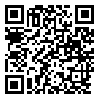دوره 23، شماره 1 - ( 12-1403 )
جلد 23 شماره 1 صفحات 94-87 |
برگشت به فهرست نسخه ها
Download citation:
BibTeX | RIS | EndNote | Medlars | ProCite | Reference Manager | RefWorks
Send citation to:



BibTeX | RIS | EndNote | Medlars | ProCite | Reference Manager | RefWorks
Send citation to:
V M, Catherine P A, Rajasekar M. Investigating the Relationship Among Communicative Gestures and Words in Tamil-speaking Children With Down Syndrome. Iranian Rehabilitation Journal 2025; 23 (1) :87-94
URL: http://irj.uswr.ac.ir/article-1-2059-fa.html
URL: http://irj.uswr.ac.ir/article-1-2059-fa.html
Investigating the Relationship Among Communicative Gestures and Words in Tamil-speaking Children With Down Syndrome. مجله انگلیسی زبان توانبخشی. 1403; 23 (1) :87-94
چکیده: (1514 مشاهده)
Objectives: Gestural usage is one of the earliest signs of intentional communication abilities. In children with down syndrome (DS), one of the most severely compromised areas of functioning is language. In the linguistic profile of children with DS, gesture use and receptive vocabulary are relative strengths. The present study examines the relative use of types of gestures and words in children with DS. Also, this study compares that with a group of expressive language, ability-matched typically developing (TD) children. Additionally, the present research verifies the relationship between total gestures and word production by children with DS and expressive language ability-matched TD children.
Methods: In this prospective study, 30 Tamil-speaking children (15 children in the DS group and 15 children in the TD group) and their parents participated. The parents were asked to play with their children normally, as they do at home, using the set of toys given, and this session was recorded in video. Deictic gestures and words, as well as representational gestures and words, were analyzed with a specific coding scheme.
Results: The DS group used more deictic gestures (Mean±SD, 35±14.10) compared to deictic words (Mean±SD, 2.73±1.79), with a significant difference (P<0.05, Z=-3.40, P=0.00064). Also, children with DS used more representational words (Mean±SD, 46.13±22.63) than representational gestures (Mean±SD, 12.53±8.20), with a significant difference (Z=-3.29, P=0.001). Meanwhile, this was found to be a moderately positive correlation between overall gesture and word production in the DS group (rs=0.574, P=0.02) and TD group (rs=0.558, P=0.03). This study revealed no significant difference between children in the DS and TD groups regarding the use of deictic gestures and words. Additionally, there was a significant difference in the use of representative gestures (P=0.0018) and words (P=0.02) between DS and TD groups. Children in the DS group used more representational gestures compared to children in the TD group.
Discussion: Children in the DS group exhibited an association between gesture and word production during parent-child interaction, which is similar to children in the TD group. This relationship persists despite specific issues with DS children’s expressive language traits. Children in the DS group used more representational gestures compared to children in the TD group to compensate for their deficits in speech and language skills.
Methods: In this prospective study, 30 Tamil-speaking children (15 children in the DS group and 15 children in the TD group) and their parents participated. The parents were asked to play with their children normally, as they do at home, using the set of toys given, and this session was recorded in video. Deictic gestures and words, as well as representational gestures and words, were analyzed with a specific coding scheme.
Results: The DS group used more deictic gestures (Mean±SD, 35±14.10) compared to deictic words (Mean±SD, 2.73±1.79), with a significant difference (P<0.05, Z=-3.40, P=0.00064). Also, children with DS used more representational words (Mean±SD, 46.13±22.63) than representational gestures (Mean±SD, 12.53±8.20), with a significant difference (Z=-3.29, P=0.001). Meanwhile, this was found to be a moderately positive correlation between overall gesture and word production in the DS group (rs=0.574, P=0.02) and TD group (rs=0.558, P=0.03). This study revealed no significant difference between children in the DS and TD groups regarding the use of deictic gestures and words. Additionally, there was a significant difference in the use of representative gestures (P=0.0018) and words (P=0.02) between DS and TD groups. Children in the DS group used more representational gestures compared to children in the TD group.
Discussion: Children in the DS group exhibited an association between gesture and word production during parent-child interaction, which is similar to children in the TD group. This relationship persists despite specific issues with DS children’s expressive language traits. Children in the DS group used more representational gestures compared to children in the TD group to compensate for their deficits in speech and language skills.
نوع مقاله: پژوهشي |
موضوع مقاله:
گفتار درمانی
دریافت: 1402/6/6 | پذیرش: 1403/6/6 | انتشار: 1403/12/11
دریافت: 1402/6/6 | پذیرش: 1403/6/6 | انتشار: 1403/12/11


